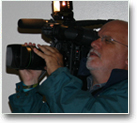 Keeping An Eye On Enigmatic OwlsFOR IMMEDIATE RELEASE Trent Ornithologist’s Saw-whet Owl-Banding Project Reveals Unusual Migration Patterns Thursday, September 25, 2008, Peterborough
“It’s important to establish if the males and females are wintering in different places,” explained Prof. Nol. “As monogamous birds, understanding the differential habitat use by the two sexes may bias population figures when trying to determine the potential effects of winter habitat loss.” Since 1999, Prof. Nol has been leading an annual owl-banding project at the James McLean Oliver Ecological Centre, a 270-acre waterfront property that was donated ten years ago to Trent for use in wildlife research that is located just 50 minutes north of Peterborough. The Centre is being carefully developed as a residential field station for teaching, and for long-term ecological research. Very little is known about the abundance and distribution of owls in Ontario, which is crucial for conservationists who want to know more about their sensitivity to habitat change and forest fragmentation. Owls’ nocturnal behaviour often conceals them during the day, making them notoriously difficult to count. However, banding programs are considered one of the most efficient ways to acquire information about them. A recording device playing saw-whet owl sounds is set up near the nets to entice them into the area. Last year, a total of 220 owls were captured and banded in a 40-day period with an average of 5.58 owls per night. “This figure is remarkable considering that only five nets were in operation, as opposed to nine used in years prior to 2006, when the nightly average was about three,” said Prof. Nol. “This was also the first year that we caught a good proportion of males, although the majority of the owls were female.” Prof. Nol noted that from this study female saw-whets seem to migrate more than males, indicating that the sexes do tend to winter in different areas. “2006 was a synchronous mast year for the trees, which means they were unusually productive providing lots of fruit and seeds for small mammals to eat, and resulting in a spike in owl populations,” explained Prof. Nol. “However, the small animals eat all the food and then die off during the winter which means smaller mammal populations for owls the following year. Thus, this reduction in food might have triggered the larger migration out of the breeding areas in 2007." Another interesting finding was the recapture of six owls from distant locations, such as Wisconsin, Manitoba, Virginia and Thunder Bay, Ontario, revealing how widely distributed these birds are in Eastern North America. What was most surprising to Prof. Nol in the 2006 study, however, was the discovery that saw-whet owls can migrate in reverse directions. “This is new information, and is something we’ve never seen before in owls,” she said. In addition to the valuable data that this ongoing study provides, another great benefit of the owl-banding project is the awareness it raises about owls and habitat conservation. “It’s an exciting volunteer project, and I enjoy being able to teach people when they have a bird in their hands,” Prof. Nol explained. “Once people get to hold the owls, they just fall in love with them. The owls have become great ambassadors for the bird world!” -30- For further information, please contact Professor Erica Nol, Biology Department, Trent University at (705) 748-1011, ext. 7640 |

































 The mysteries behind Northern Saw-whet owls (Aegoius acadicus) have kept Professor Erica Nol up late at night on more than one occasion. In fact, beginning October 1 she and a team of volunteer bird banders will stay up well past dark waiting for the 15 cm creatures to fly into her nylon mesh nets so they can be weighed and measured to determine their age, sex, wingspan, and fat content.
The mysteries behind Northern Saw-whet owls (Aegoius acadicus) have kept Professor Erica Nol up late at night on more than one occasion. In fact, beginning October 1 she and a team of volunteer bird banders will stay up well past dark waiting for the 15 cm creatures to fly into her nylon mesh nets so they can be weighed and measured to determine their age, sex, wingspan, and fat content.